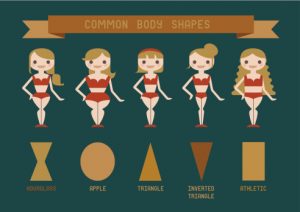 Type 2 diabetes risk may be predicted by a women’s body type by examining her hip circumference, according to new findings. There are many different body types: banana (straight from shoulders down), apple (wider top half, thinner lower half), pear (wider hips, thinner top), and hourglass (thin at the waist, rounded bust and hips). Even though we may have our own preferences, body shape goes further than visual appeal.
Type 2 diabetes risk may be predicted by a women’s body type by examining her hip circumference, according to new findings. There are many different body types: banana (straight from shoulders down), apple (wider top half, thinner lower half), pear (wider hips, thinner top), and hourglass (thin at the waist, rounded bust and hips). Even though we may have our own preferences, body shape goes further than visual appeal.
New research suggests that those with a pear body shape are least likely to develop type 2 diabetes. The findings were presented at the American Society of Human Genetics 2015 annual meeting.
Advertisement
Women’s body shape may predict diabetes risk
 A pear shape best describes a body type where the hips are larger. Previous research showed that women with larger hips were “significantly less likely” to develop diabetes than women with smaller hips, but the question of why has still very much remained unanswered.
A pear shape best describes a body type where the hips are larger. Previous research showed that women with larger hips were “significantly less likely” to develop diabetes than women with smaller hips, but the question of why has still very much remained unanswered.
Researchers found a genetic variant known as KLF14, which regulates genes regarding where a woman stores fat. If fat is stored in the hips, then that offers better protection against type 2 diabetes, which is categorized by fat being stored in the abdominal region.
The gene is inherited from a woman’s mother and the effects of the gene were studied in a large genome of a broad population.
Although risk of diabetes was modest, the numbers were still significant enough. When studying the specific gene the numbers grew.
Dr. Kerrin Small, lead researcher, said, “These findings have important implications as we move toward more personalized approaches to disease detection and treatment. If we can identify the genes and protein products involved in diabetes risk, even for a subset of people, we may be able to develop effective treatment and prevention approaches tailored to people in that group.”
Dr. Small concluded, “Eventually, we hope to develop a comprehensive, predictive model of how genes affect risk of type 2 diabetes in women.”
Understanding your body type for type 2 diabetes risk
 As mentioned, those who store fat in their abdominal region – or apple shaped individuals – are at a higher risk of developing type 2 diabetes. However, being overweight increases the risk more than your body shape, so the real solution is to maintain a healthy weight.
As mentioned, those who store fat in their abdominal region – or apple shaped individuals – are at a higher risk of developing type 2 diabetes. However, being overweight increases the risk more than your body shape, so the real solution is to maintain a healthy weight.
As the new study outlines, where our bodies store fat is genetically determined, but it doesn’t mean you can’t still change how much fat you have. If you want to uncover your risk of diabetes, it starts with pulling out a measuring tape.
Wrap a measuring tape around your waist. For men the ideal goal is to be less than 40 inches around – being at this number or above increases your risk of type 2 diabetes. For women, it’s important to stay below 35 inches.
Excess body fat and its role in type 2 diabetes
We know that excess body fat can contribute to diabetes, but may never have stopped ourselves to ask why. Well, it turns out the main culprit is insulin resistance.
Insulin resistance refers to the body’s inability to effectively use insulin. Excess body fat around the abdomen can contribute to insulin resistance, although it is unclear how this exact mechanism works. What is known is that fat cells impair insulin’s ability to work properly, and the larger the fat cells, the more insulin resistance will occur.
To put this into perspective, by gaining 10 pounds over the span of 15 years the risk of insulin resistance doubles, and so does your diabetes risk. Insulin resistance can lead to other health complications as well, such as high blood pressure and an increase in bad cholesterol (LDL).
If you’re concerned that your excess fat is putting you at risk for insulin resistance and diabetes, you don’t need to fret – there are things that can be done to change the amount of fat you have and lower your risk.
Changing shape and reducing your risk of type 2 diabetes
Even though genetics may play a role in where fat is stored, it’s up to you whether or not it becomes stored for good. There are three main components that can contribute to a changed shape, they include: physical activity, healthy eating and weight.
 Physical activity:
Physical activity:
We know that to lose weight and change our body exercise is necessary. Exercise conditions our body by strengthening muscles, improving cardiovascular health and, above all, burning off excess calories, which contribute to weight gain.
Aside from changing a person’s shape physical activity can also improve blood pressure, cholesterol, relieve stress, improve heart function, increase circulation and keep the joints and body flexible.
There are different types of physical activity that can target different areas, but essentially all can aid in weight loss. Types of exercise are:
- Activity – walking, using the stairs
- Aerobic – dancing, swimming, brisk walking
- Strength – the use of weights
- Flexibility – stretching
As you can see, exercise can be as simple as completing daily activities to more complicated, carefully planned and requiring additional equipment. The goal is to find exercises you enjoy so you stick with it.
Healthy eating:
What we put in our mouths can directly translate to what body shape we have. Healthy food provides nutrients that our bodies can use for good, instead of being stored and leading to an energy-crash.
Healthy eating may seem difficult because it can be time consuming to prepare or sometimes more costly, but as with anything, it involves effective planning. Here are some tips to improve your eating habits.
 Use a grocery list when shopping and include healthy food items.
Use a grocery list when shopping and include healthy food items.- Buy leaner meats and avoid red meat.
- Buy whole grains.
- Purchase less snack foods and soda.
- Just because something says “diet” doesn’t mean it’s necessarily better for you – ensure you always read labels to know what you’re buying.
- Plan weekly meals in advanced.
- Stock your pantry with healthy staples, such as brown rice and whole grains.
- If you can’t get fresh, frozen fruits and vegetables are still good options – plus they will last longer.
- Purchase healthy food when you’re running low – not when you completely run out.
- Avoid aisles with junk food and sugary options.
- Don’t shop when you’re hungry.
- Eat the majority of vegetables in the earlier part of the day.
- Avoid fried food and ask for sauces and dressings on the side when you eat at restaurants.
Weight:
Losing 10 to 15 pounds when you’re overweight can go a long way towards improving your overall health. Being overweight is associated with many health consequences, not just diabetes. The goal is to utilize healthy eating and physical activity together in order to change your shape and maintain a healthy weight.
Losing weight and cutting back on bad habits can be difficult, but beginning with small steps will soon turn into large steps and you will begin to notice major differences. Tips to lower your weight include:
- Begin cutting out high-calorie snacks and extra fat.
- Begin increasing your physical activity week after week.
- Eat breakfast daily – ensure it contains protein, whole grains and healthy fat to stay fuller, longer.
- Keep a record of your physical activity progress, along with weight changes.
- Recruit a buddy to begin these changes with you as support. The both of you can hold each other accountable throughout your journey.
Eventually you won’t even have to think about your healthy lifestyle choices as they will become part of your daily life.
So, if you want to know what your risk of diabetes is, look no further than the mirror and begin making healthy changes as soon as possible.
Related Reading:
You’re at risk for diabetes if you have these symptoms
Diabetes affects roughly 29.1 million Americans, and with such a high prevalence most people think they know just about everything in regards to the disease. For example, you probably know diabetes is a condition that affects blood sugar. You also know diet and exercise are essential for proper management. Continue reading…
Advertisement
Gastric bypass surgery may reverse type 2 diabetes
Remission of type 2 diabetes has been found to be possible with weight loss surgery, specifically gastric bypass surgery, according to new findings. Insulin is responsible for transferring glucose into the bloodstream where it can be used by tissues and cells as energy. Continue reading…
Sources:
http://www.medicaldaily.com/hips-dont-lie-womans-body-type-may-predict-her-risk-type-2-diabetes
http://www.everydayhealth.com/type-2-diabetes/body-shape-affects-diabetes-risk
http://www.bd.com/us/diabetes
http://www.diabetes.org/are-you-at-risk/lower-your-risk/activity
